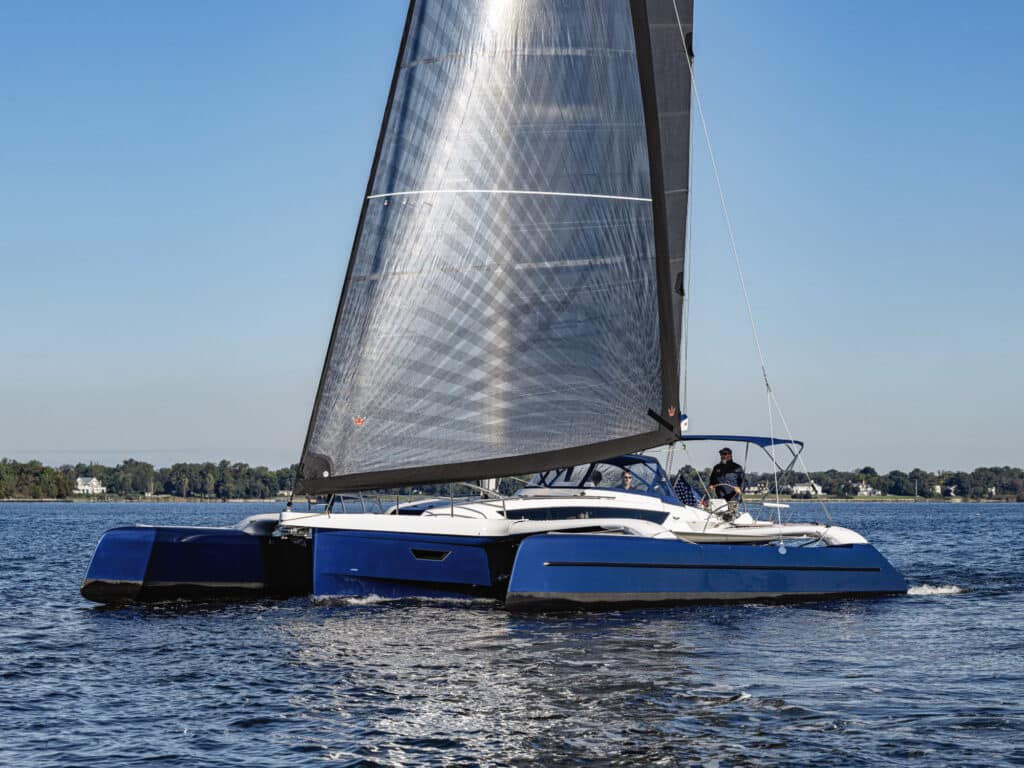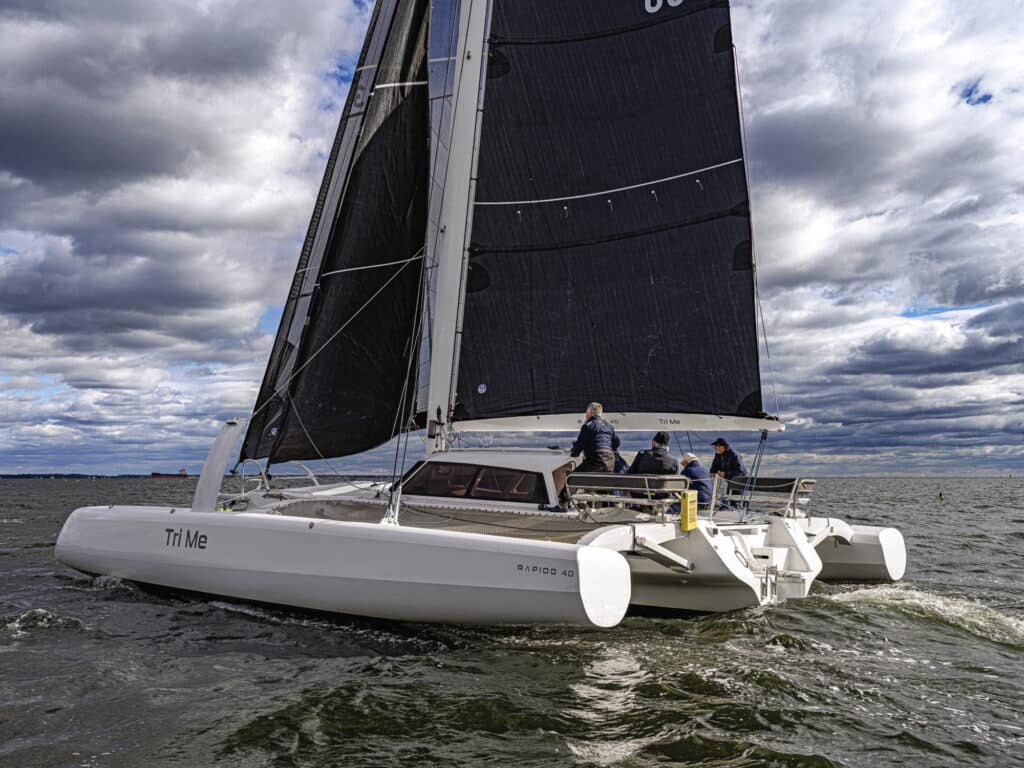
For the first time ever in the 29-year history of Boat of the Year, we’re introducing a new class to the proceedings: Performance Trimarans. To make things spicier, the two nominees not only shared the same length overall of 40 feet, but they also came in at the near-identical price point of around $800,000 for the base boat.
Beyond those two parameters, however, the different approaches from these disparate brands were interesting and exciting. Cruising trimarans, though rare, are nothing new; the well-established Neel line of French-built trimarans has enjoyed plenty of success in previous BOTY contests. With that said, the judging panel was champing at the bit to put these fresh three-hull whizzes through their paces. And once under sail, we were definitely not disappointed.
Winner: Dragonfly 40
Let’s cut right to the chase: The Dragonfly 40 had judge Tim Murphy swooning straight from hello: “This is an exquisite yacht in every detail. When you step aboard, the new-boat smell was not of styrene but of a wood shop. Built in Denmark by the Quorning family (designer and builder Jens Quorning took us on the test sail), it’s just a beautiful boat to look at from across the water. The wheel steering—no tiller here—was butter-smooth. Thanks to the boat’s extremely fine hulls, on our test sail we hardly felt any jerks or deceleration as we passed through several Severn River boat wakes. There were AGM batteries on this boat, but a lithium-battery system is an option. The kick-up centerboard and rudder are ingenious: Quorning as much as invited us to ground the boat on a shoal. From barber haulers to boom preventers, it’s full of great sailing details.”
Judge Mark Pillsbury was equally impressed: “As we finished up our all-too-brief sea trial aboard the Dragonfly 40, I scribbled ‘Top shelf!!!’ in my notebook. We had the benefit of sailing the boat with its thoroughly detail-oriented builder, who pointed to the seemingly endless features he’d employed to make this maybe the most memorable sailing boat of the year. At one point, I looked down at the GPS speed-over-ground number, which read 6 knots, then glanced at the true wind gauge: 5.2! Faster than the wind! The interior of the Dragonfly was elegant, with the furniture rendered in elm—not a wood we often see. But most impressive was the walk-in aft cabin instead of the crawl-in bunk often found in the narrow confines of a tri’s slender center hull.”
Judge Herb McCormick was as astonished as his colleagues: “There isn’t a thing on the Dragonfly that Quorning hasn’t thought long and hard about, and then executed to a stellar degree. Take that centerboard arrangement, which is built into the central dining table and is integrated so well into the interior that it’s a functional piece of furniture as well as a foolproof cruising solution. What else can we say? It’s a magnificent freaking boat.”
Runner-up: Rapido Trimarans 40

The design brief for the Rapido 40 is straightforward: fast cruising and racing for a couple or crew; ocean-ready but able to sail and moor in shallow water. Nobody was more psyched to sail the boat than judge Herb McCormick, who was not disappointed.
“I was first exposed to the brand at a multihull regatta in the Caribbean, where a larger Rapido 50 was in attendance,” he said. “I was on another boat, and we spent a lot of time looking at the Rapido’s transom. Then I stepped aboard the Rapido 40 for our trials and was handed the tiller extension; under the code zero, in about 15 seconds, we were making 14 knots. Whoa!”
Judge Mark Pillsbury said: “From stem to stern, the Rapido 40 came packed with features, including a double-taper carbon rotating mast, a Park Avenue-style boom for easy sail handling, daggerboards for upwind performance, and a very comfy cockpit. There’s an optional all-carbon version of the boat, including the drawers in the galley. The layout, with a comfortable V-berth and raised table in the salon—offering outstanding views of the great outdoors—is cruising-couple friendly.”
Judge Tim Murphy added: “The Rapido 40 is built in Vietnam by Paul Koch, the previous owner of Corsair Marine who started Rapido Trimarans in 2014. Rapido builds three models, all designed by the renowned team of Morrelli & Melvin. Our test boat had the standard infused construction, which is mostly E-glass with vinylester resin and a PVC core. There’s also carbon fiber near the bulkheads where the crossbeams meet. Carbon-fiber C-foils in the amas are intriguing and provide lift in two directions: up (to reduce sailing displacement but not fly) and to windward. Sailing the boat on the raised web seat with the tiller extension is gorgeous. It feels very sporty. Rapido’s latest claim to fame: The YouTube channel Sailing La Vagabonde has taken delivery of a Rapido 60, which will definitely raise the profile of the brand.”








